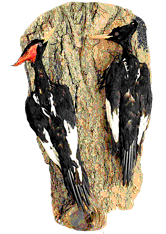 CENTENNIAL MUSEUM-CHIHUAHUAN DESERT GARDENS—THE UNIVERSITY OF TEXAS AT EL PASO
CENTENNIAL MUSEUM-CHIHUAHUAN DESERT GARDENS—THE UNIVERSITY OF TEXAS AT EL PASO
IMPERIAL WOODPECKERS
Male (L) and Female (R )Centennial Museum Collection
Scientific name: Campephilus imperialis (Gould, 1832)
Classification
Kingdom: Animalia
Phylum: Chordata
Class: Aves
Order: Piciformes
Family: Picidae
Common names in Mexico
Spanish: Pitorreal
Nahuatl: Cuauhtotomi
Tarahumara: Cumecócari
Tepehuan: Uagam
Description
The largest woodpecker in the world, with the male at approximately 22 inches long, is primarily black with an elongated occipital red crest, white wing patch and thin white braces on the
mantle forming a "v", and white secondary feathers. The bill is ivory, the eyes are golden yellow, and the zygodactyl feet are grey. The female is similar except it has a black, curling
crest. The Imperial is 20% larger than its closest relative, the Ivory-billed Woodpecker.
Critically Endangered (Possibly Extinct)
1970—Listed under the U.S. Fish and Wildlife Services Endangered Species Act
2005—International Union for Conservation of the Nature and Natural Resources (IUCN) Red List
Last confirmed sighting was in 1956, with eight later local reports in two remote areas after 1965 and a last sighting in 1996 in Durango. Mechanical logging and the removal of dead trees
have destroyed habitats. Use as a food source, as well as various beliefs in health benefits of bird parts (i.e., plumage and bill), by indigenous peoples have contributed to its probable
extinction.
Distribution
Once wide-spread throughout the Sierra Madre Occidental in México (above 6500 feet in the northern part and 8000 feet in the southern part) in Sonora, Chihuahua, Durango, Nayarit,
and possibly Zacatecas, with isolated populations in western Jalisco and Michoacán
Home
Prefers high-altitude pine-oak forests with dead trees and snags for feeding and nesting. Density is one pair per 10 square miles.
Diet
Scales back bark of dead trees and feeds on insect larvae.
Breeding
Between February and June with clutches of 1-2 eggs. Young probably stay with parents until next nesting season.
Voice:
Reportedly sounds like a toy trumpet.
